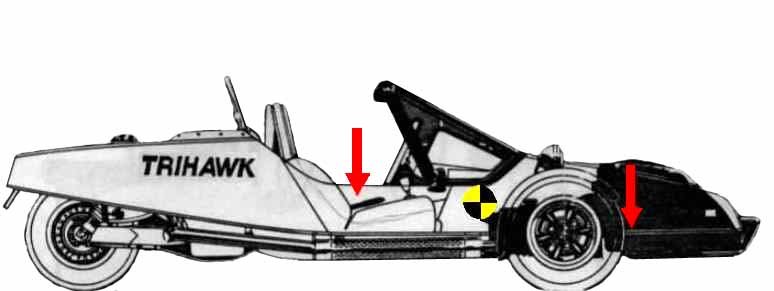Fifth component layout: 3-Wheelers having two front driving and steering wheels. These wheels pull and steer the vehicle, while the rear wheel simply follows.
The Escargot based on a Citroën 2CV might have been the first one made. But the 1982 Trihawk was the first to demonstrate the potential of this concept. This 3-Wheeler was manufactured in limited quantities during the 1980’s by Hawk Vehicles Inc., which was later bought by the Harley Davidson company (More history at History of the Trihawk and Trihawk was a car/motorcycle hybrid):


Today, the Lomax and the Blackjack Avion can both be found in Great Brittain.


These 3-Wheelers with two front driving and steering wheels resolve the rollover problem in a very simple way:
The engine is located in front of the two front wheels, and the passengers are located behind these front wheels, as represented by the two red arrows on the illustration at the right.
The engine and passengers being in front and behind the front wheels, the center of gravity (yellow-black circle) of the vehicle-occupants assembly is located close to these two front wheels that provide stability against rollover.
So nearly like a car, the center of gravity is in between the wheels on each side of the vehicle.
Thus, without any added component weight and complexity, this 3-Wheel type can be as stable as a car on the road and cannot be rolled over in curves in normal use.
Moreover, the Road & Track magazine tested the Trihawk (PDF file Trihawk 304 – Road&Track May 1982). In a slalom course, it was faster than the Audi Coupe and the Porsche 924. On the skidpad (a constant radius circle), the Trihawk was only beaten by four cars: The BMW M1, the Ferrari Boxer, the Lamborghini Countach and the Porsche 930 Turbo. “Lofty company indeed”, they added.
Our new 3-Wheeler vehicle is an improvement to this two-front-driving-and-steering-wheel concept.
Conclusion:
This 3-Wheeler component layout with two front driving-steering wheels lends not only a stable vehicle on the road, but a sporty one.
